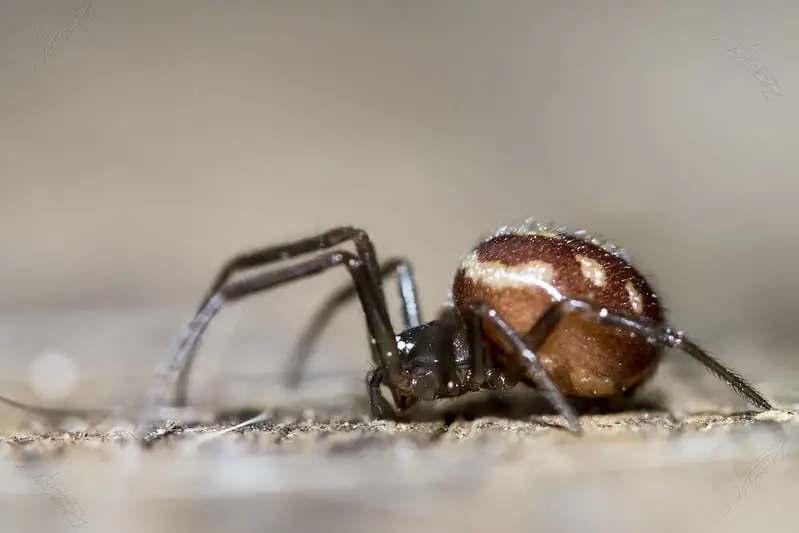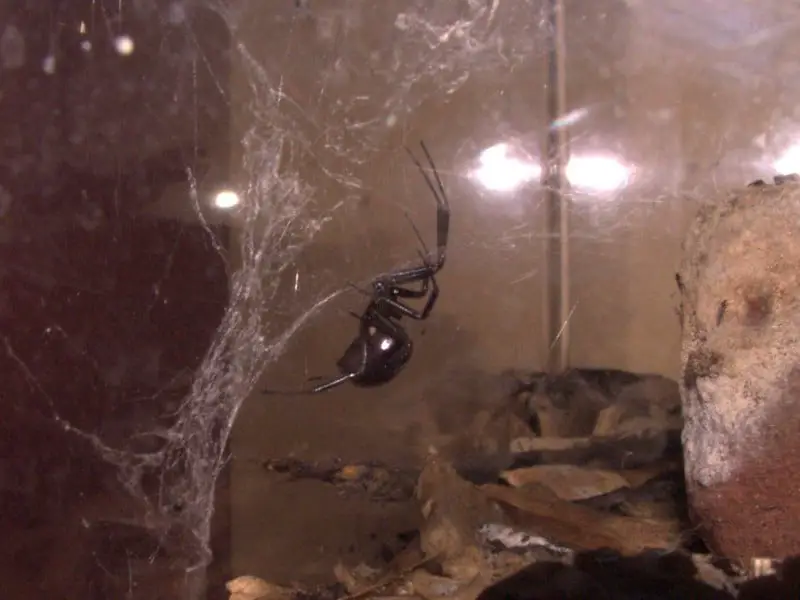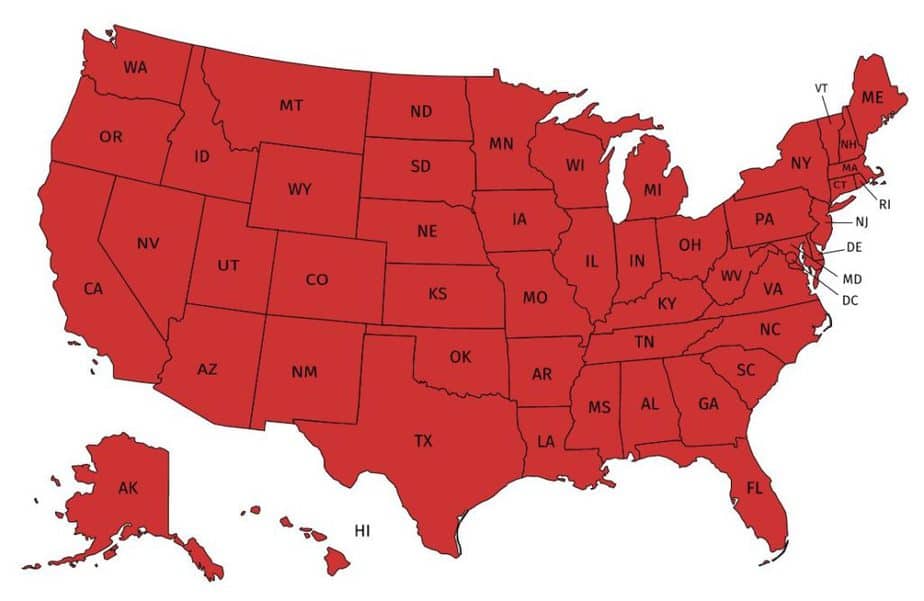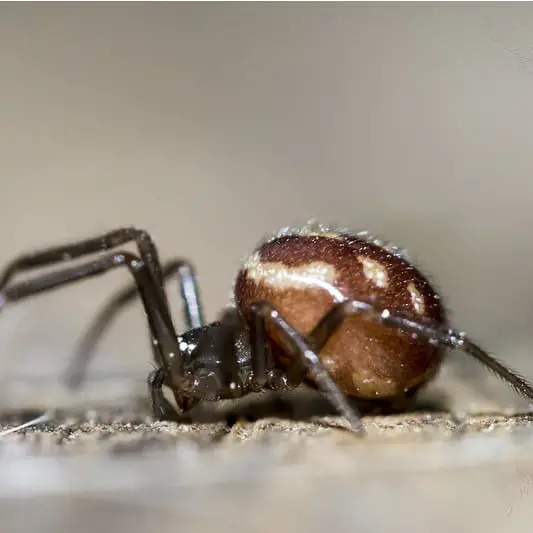The Steatoda grossa, commonly called the false black widow spider or cupboard spider can be found throughout the United States. It is from the family of Theridiidae, the same as the black widow spiders. They build similar webs and have a similar body shape and color as black widows. Hence, their common name false widow. The bite of a false black widow spider is considerably less severe than a real widow’s bite. However, it is one of the few species that are considered medically significant as the bite can cause severe pain. It is from the same genus as the Steatoda triangulosa and the Steatoda bipunctada.
Steatoda grossa is an imported species that originated in Europe. In the United States, it occurs most often along the East Coast as well as in California. But over the last years, it has spread throughout the United States and can be found in every state.
False Black Widow Spider Description
Steatoda grossa has a similar body shape as the real widow spiders of the genus Latrodectus. The abdomen of the female is large, bulbous and round. Their body color ranges from light brown to purplish to deep black. Especially older female specimen are often confused with black widows. If you can catch a glimpse at the underside of the abdomen and you cannot see a red hourglass shape, it is not a real black widow and you are most likely dealing with a false widow. If the general color of the body is more like a dark purple instead of black, it is also an indication for a false widow.

Size
The female false black widow normally has a body size of 0.25-0.40 inches (6-10 mm). Their total leg span is about 1 inch (25 mm). The male is slightly smaller and has an oblong abdomen.

Web
Steatoda spiders are part of the cobweb spider family. They don’t spin beautiful round webs like orb weavers in the open. Their webs are tangled and irregular with unorganized strands of sticky silk. They often build their webs in corners of buildings or other crevasses and spend most of their time inside their web waiting for prey to get tangled up in it. This has also earned them their other common name Cupboard Spider.
Interestingly enough, one of the preferred prey are real black widow spiders as well as other small creatures.

False Widow Bite
The Steatoda grossa is, like the other species from its genera, a timid spider. Whenever a human or a large animal gets close to their web, they will be able to feel the vibrations and hide away from the danger. They only bite if they feel immediately attacked or trapped. Never touch a cobweb in a corner with your hands, use a broom or another tool to avoid being bitten in the hand.
The bite of a false widow is not considered medically significant. That means that the bite itself can be painful and cause blistering in the area around the bite. In addition, the bite may lead to a general discomfort and even fever for several days. The bite does not cause any long-term effects and is not as severe as the bite of a real black widow.
Scientific Classification of Steatoda grossa
- Kingdom: Animalia
- Phylum: Arthropoda
- Subphylum: Chelicerata
- Class: Arachnida
- Order: Araneae
- Infraorder: Araneomorphae
- Family: Theridiidae
- Genus: Steatoda
- Species: Steatoda grossa
Other common names
Steatoda grossa is known under the following common names: False widow spider, false black widow spider, cupboard spider, brown house spider and dark comb-footed spider.
False Widow Spider Range in the USA

The Steatoda grossa can be found throughout the United States in the following states: Alabama, Alaska, Arizona, Arkansas, California, Colorado, Connecticut, Delaware, Florida, Georgia, Hawaii, Idaho, Illinois, Indiana, Iowa, Kansas, Kentucky, Louisiana, Maine, Maryland, Massachusetts, Michigan, Minnesota, Mississippi, Missouri, Montana, Nebraska, Nevada, New Hampshire, New Jersey, New Mexico, New York, North Carolina, North Dakota, Ohio, Oklahoma, Oregon, Pennsylvania, Rhode Island, South Carolina, South Dakota, Tennessee, Texas, Utah, Vermont, Virginia, Washington, West Virginia, Wisconsin, Wyoming


two of these outside our home. Sorry for the bad pictures, it’s as close as I wanted to get
This one has banded legs with bright orange banding closer to the body. Keeps a web which catches insects. Possibly a rabbit hutch spider?
Please identify this spider.
Thanks,
Steve
Norhern Kentucky
The bite is absolutely NOT medically significant.
Hi Doug, wow, that was an unfortunate typo! Thanks for pointing that out. It has now been corrected. The bite of the false widow is not medically significant.
i call the false blackwidow spider a [blue rebbon spider] if you live in a red state porcea manogea spiders are the pet spider for you .
my favorite spider is the false blackwidow i like the males i see them as democrat type whereas orb weavers and spiders from china are red state types
Hi there – I saw this beautiful spider in the channeled scablands (sagebrush desert) of eastern Washington state. It’s <1/2 inch and had a messy web in a small depression amidst dirt, grasses, and rocks. I didn't have any luck identifying it with your sorting tool. Hoping someone might know what it is. Thanks, Maureen
Hi Maureen, it’s hard to make a definitive ID off this picture alone. The cobweb suggests that this is a spider of the family Theridiiae. Due to the body color, it can’t be a black widow spider. Therefore, it is most likely some type of false widow spider, probably Steatoda grossa:
https://usaspiders.com/steatoda-grossa-false-widow-spider/
my favorite spider is the false blackwidow especially the males i wand to see videos of a male false blackwidow beating a common male house spider and a male black widow, and a male brown widow and a male red widow spider. the male false black widow is KING
Big abdomen about the size of a marble, very slick and glossy, long back legs, long front legs, medium and short middle legs. Very deep black color, legs have patches of brown in some areas, very strange markings on the abdomen, reminds me of a cyclops with a big smile towards the front. I’m curious what it is?
20210605_024222
Hello Paul, thanks for reaching out! The shape of the abdomen and legs indicates that this is some type of female cobweb spider of the family Theridiiae. Since there is no red hourglass shape on the underside, it is not a black widow but a spider of the genus Steatoda (false widows). Assuming that the spider was found somewhere in the United States, it is most likely Steatoda grossa: https://usaspiders.com/steatoda-grossa-false-widow-spider/
Steatoda grossa typically builds webs under boards, under debris and in secluded areas like water meter housing or under furniture. It would be highly unusual for a Steatoda to be building a web out in the open or under the eves of a house. This image is likely an araneid (orb weaver).
the flase blackwidowspders are what i call blue ribbon spiders.
I found this in my mailbox. I did not roll it over to see if it had the red hour glass on its abdomen. But it had the body shape I associate with the black widow. Any idea what it is. I live north of Detroit.
Hello Marc, thanks for getting in touch! This is a false black widow spider of the genus Steatoda. They have a similar body shape as black widows but are not medically significant. Black widows are entirely black and Steatoda sp. spiders usually also have some brown or purple colors like your spider does. So there is no need to turn them around. My best guess is that this is a Steatoda grossa: https://usaspiders.com/steatoda-grossa-false-widow-spider/
My favorite spider the false widow mine are blue🔵 ribbon spiders.🙂 there’s a rival spider called the {manogea porracea} It’s a red state spider that if mine are to battle they have to battle hard and win against.
the flase black widow spider is my faviorite spider
Found sitting on a pile of light pink eggs inside my hose storage box, in Suamico Wisconsin. I’ve never seen eggs this color! Relatively small/medium spider, dark brown color with very vaguely reddish stripe down abdomen.
Hello Kate, thanks for getting in touch! This is definitely some species of cobweb spider (Theridiiae). Judging from the picture, I would say that this is a false widow spider (Steatoda grossa): https://usaspiders.com/steatoda-grossa-false-widow-spider/
If the spider has a red hourglass marking on the bottom of its abdomen, it could be a northern black widow (Latrodectus variolus): https://usaspiders.com/latrodectus-variolus-northern-black-widow/
I’d recommend handling it with care but the presence of brown color on its body suggests that it is a false black widow which is not medically significant.
I live in CA and found this spider outdoors right above my garage door. I’m wondering whether to worry about it or not. Thanks.
Please identify these spiders. They are on same web.
Thank you, Belinda
Hello Belinda, thanks for getting in touch! Can you tell me where you found the spiders (City, US State)? That will help with the identification. Thanks!
It was found in my garage in Somerset, Massachusetts.
Thanks for that information. The two spiders are definitely a male and a female Steatoda spider. The larger darker spider is the female. The smaller spider is the male.
Unfortunately, it is hard to tell what species they are exactly without seeing the upper side of their bodies (and even then it can be hard). Steatoda spiders are close relatives of the black widow but they are not medically significant. Here is an overview of some common Steatoda spiders: https://usaspiders.com/theridiidae/steatoda/
Thank you very much for the information.
As for me my favorite spider is the false blackwidow spider especially the males I had one as a pet his name was D’Angelo he was in a big cage with crickets he ate he caught off rival male spiders like the common house spider males. I have some now they’re females I’m hoping to get a male also there’s a new rival spider from Britain it’s {manogea porracea spider} males if mine caught one of those over territory I’m not sure who would win in this case it would be a big battle. My spiders are blue🔵 ribbon spiders the rival male spiders I mentioned are red state spiders
Please identify these spiders. They are on same web. Here is the 2nd spider. It is much smaller, 1/3rd of size.
Thank you, Belinda
Found this scary looking little lady in the corner of my office in Vermont. There was no red marking, so my guess is Steatoda Grossa. Very interesting looking creature!
i found this spider in los angeles california. it was fr crawling on the side of my face. i’d like to know if i could’ve died, thanks
Hello Angel, thanks for getting in touch! To answer your last question first: dying from a spider bite is extremely unlikely. Spider bites generally only lead to death for people with preconditions or very strong allergies. In fact, around ten times more people in the U.S. die from bee or wasp bites than from spider bites (40 vs. 4 people per year on average).
Having said that, this is not one of the medically significant spiders found in the U.S. This is a male false widow, or cupboard, spider. They are related to black widows but not nearly as venomous, especially not the male. The marking on the back indicates that this might be Steatoda grossa: https://usaspiders.com/steatoda-grossa-false-widow-spider/
Found in Southern California (LA)
Hi Eric, this is some type of false widow spider, or cobweb spider, in the genus Steatoda. My best guess is that this is Steatoda grossa:
https://usaspiders.com/steatoda-grossa-false-widow-spider/
Here is a very similar-looking specimen:
https://bugguide.net/node/view/712567/bgimage
the false blackwidow spiders are classics greatest especially thev males they protect territory and their mate veeery well. call them blue ribbon spiders. if you want to read up on on spider i sugest you read or get the real red state spiders manogea porrcea spiders as pets.
Found this hanging above my garden here in PA. Is it a black widow? If not it is awfully close
Found this guy running around the bedroom in southern california.
I think ive id it as a Steatoda Grossa false widow spider or cupboard spider!
Hello Shaun, yes, it is definitely a male cobweb spider (Steatoda sp.). And I also agree that it is most likely Steatoda grossa.
?
This looks like a Woodlouse Spider (Dysdera crocata) to me…. ginormous ‘fangs’ to puncture woodlouse…aka roly poly.
Anyone know what this one is? No markings or hourglasses on underside.
Oklahoma City, OK
Pretty sure that this is a black widow. It was in my garage. Roughly the size of a quarter. It has since shuffled off its mortal coil.
Hello Daniel, this is either a black widow (Latrodectus sp.) or a false black widow (Steatoda grossa). My guess would be Steatoda and not black widow. Here is a similar-looking specimen: https://bugguide.net/node/view/488453
A picture of the underside would give certainty. If there is no red hourglass-shaped marking on the underside, it is definitely not a black widow.
Found in basement in Washington state.
Hello Steve, thanks for getting in touch! This is a male false widow (Steatoda grossa): https://usaspiders.com/steatoda-grossa-false-widow-spider/
It’s not a medically significant spider.
Found in linen closet, Seattle, WA
It bit me but looks like I shouldn’t be too worried! Hobo or triangulated? Thanks
Hi Chrissy, thanks for getting in touch! This is a male false black widow (Steatoda grossa): https://usaspiders.com/steatoda-grossa-false-widow-spider/
Steatoda triangulosa males usually have a lighter-colored abdomen with larger triangulate patterns than S. grossa.
Found this in my sink in Virginia. What type of spider is it?
Hi Rob, this is a male false black widow (Steatoda grossa): https://usaspiders.com/steatoda-grossa-false-widow-spider/
this is my favorite pet spider i have 1 male with 2 male wood spiders they’re natural enemies theyre other enemis are the male orb waever spiders
We recently received some used equipment that had be located in Orangeburg, SC for some years. We noticed an abundance of these spiders in the crates as we were unloading.
Hi Mac, this is a false widow spider (genus Steatoda). I can’t say for certain what species, but you can compare this article: https://usaspiders.com/steatoda-grossa-false-widow-spider/
The presence of brown coloration on the abdomen definitely rules out a real black widow spider.
Definitely Western Black Widow web and behavior. No red hourglass. 1 1/2″ in length. In my house, Scotts Valley, California. Solid black.
Hi Ginnie, this one looks like a black widow to me – but if there is no red or orange hourglass on the underside, it is not a widow but one of it’s close relatives, a false widow (genus Steatoda). While they are usually easy to tell apart, some Steatoda individuals can be entirely black…
I found this one in my back yard in Springfield Oregon. Any help would be awesome.
Hi Tim, thanks for getting in touch! This is a false widow spider (genus Steatoda). These spiders are related to black widows but are not considered medically significant. This one is most likely Steatoda grossa (false black widow): https://usaspiders.com/steatoda-grossa-false-widow-spider/
Hi, I live in CA, and I found this spider on the wall under my bed in the middle of the night. I did some research, and it seems to be false widow spider; However I’m not sure about this. Can anyone help me to identify it? Thanks.
My favorite spider in the world the false widow.😀🙂🙂🙂🙂🙂
Found this in southern Oregon (Medford). I’m terrible at color identification but it looks mostly brown with white markings on its back.
Hi Dave, this is a male false black widow (Steatoda grossa): https://usaspiders.com/steatoda-grossa-false-widow-spider/
If you are interested in learning more about spiders in Oregon, check out our Oregon spider identification and information book – available as an ebook here or as a printed paperback on Amazon.
the false black widow males are KING. IB WANT TO SEE THEM BEAT A MALE BROWN WIDOW, RED WIDOW, AND MALE BLACK WIDOW and plus the new spider species from china
Hello, this is not a great photo because it was shot through glass but this is one of many similar spiders that seem to have taken over my house. It was shot indoors near Grass Valley in northern California. I’m having my house treated in a couple of days but in the meantime, I would like to know what these spiders are. I thought they were black widows but after catching this one and looking at it up close I’m thinking it might be Steatoda grossa. This particular spider is no more than a couple of mm in body size but I’ve seen a few that are around the size of an ibuprofen tablet. I can’t see an hourglass on its underside but I don’t know if a juvenile black widow would have that.
I’m told that it’s uncommon for black widows to move into a home so I’m hoping that means this and the others I’ve seen are not juvenile black widows.
Thank you!
Saw this spider in my yard, in a web. Was worried it was a black widow but from looking at this page it may be a fake widow.
I didn’t get to see the belly of this, I found this in my basement and I’m worried it could be a northern black widow. When I got it outside, it played dead for a bit then came to life. Notice those 2 circle divots on its back.
Hi Jamie, my gut tells me that this is a false black widow (Steatoda grossa) because it appears to have some brownish colors. But that could be a result of the photograph and it might well be a northern black widow.
15mm, 5/8″ for whole spider, small tangled web low down in a bedroom corner, web continues behind a bookcase. Has gotten bigger since first seen. This phone picture is with a very bright LED light, under dim light it looks black with red/orange spots (got me worried.) Seems to have eliminated all the regular house spiders nearby.
NY State, near NYC.
Hi bcw, this is a false black widow (Steatoda sp.), possibly Steatoda grossa: https://usaspiders.com/steatoda-grossa-false-widow-spider/
It’s definitely not a black widow as it’s body has brown colorations. The bite can still be painful, though.
What kind of spider is this? Looks like it has pinchers.
im pro- false black widow i have one amale with 2 male wood spiders he’s king they dont know it yet i will breed him with a female orbwaver male orb weavers and male woood spider are his enemies
What kind of spider is this? I found it in my half bath in the corner of the ceiling, I knocked it down with my broom.
Found this one hanging out in my shirt sleeve and it walked down my arm. I am in Arkansas. I was not sure if it is a house spider, a false or a black widow.
I just uncovered several Steatoda Grossa spiders in a pile of bricks in my yard.
We are located in North Albany Oregon. Just thought someone might like to know about our location. These spiders had black legs and a bulbous dark brown abdomen.
July 7th, 2024
Found in a cabinet in a dusty, dirty garage SW of Portland, OR (Washington County)
I did not get a look at the under side of the abdomen…may try tomorrow to see if there is an hourglass.
Thoughts on ID?
Thanks!
I have no idea what this one is but it was crawling on the wall in my ground level apartment in Illinois. It lost grip on the wall, fell to the floor, and it started running at me but went under the rug, so I kiiinda started stomping in a panic bc my cat was close by and interested. Kiiinda looks like an hourglass on the back but it isn’t super red. It’s also VERY hairy. Please tell me it’s not a real widow, if there’s one there’s probably more and I don’t know how to get rid of them to protect my cat.
Jumped me in the garden